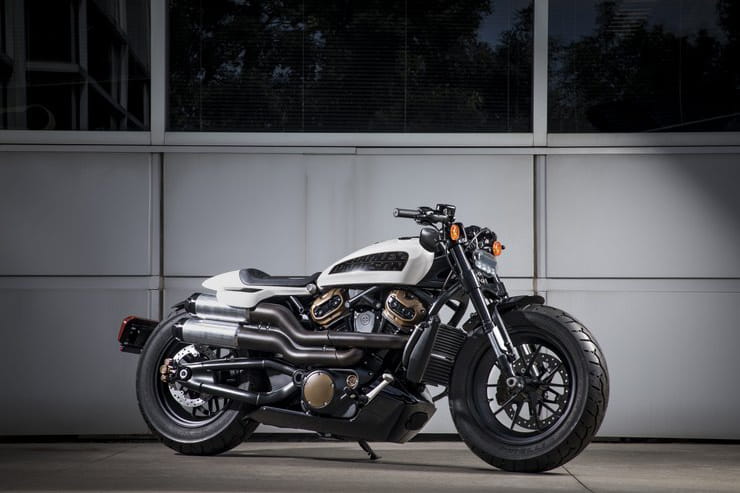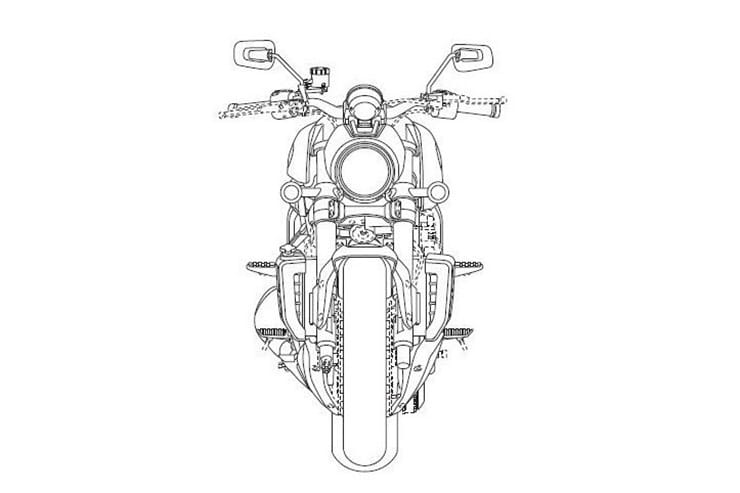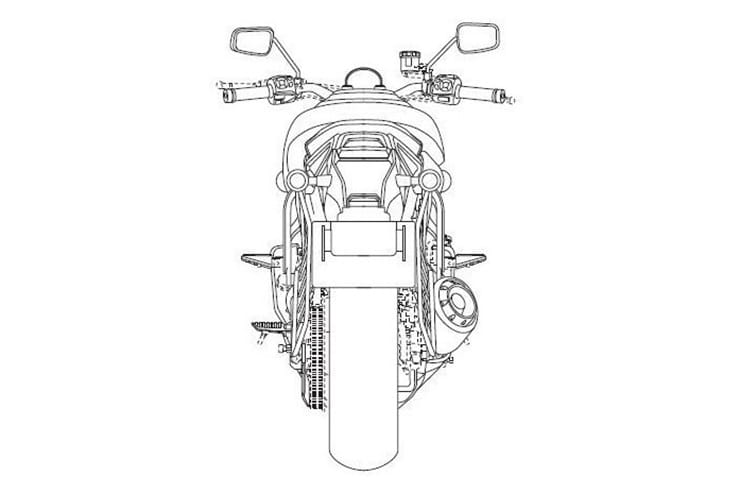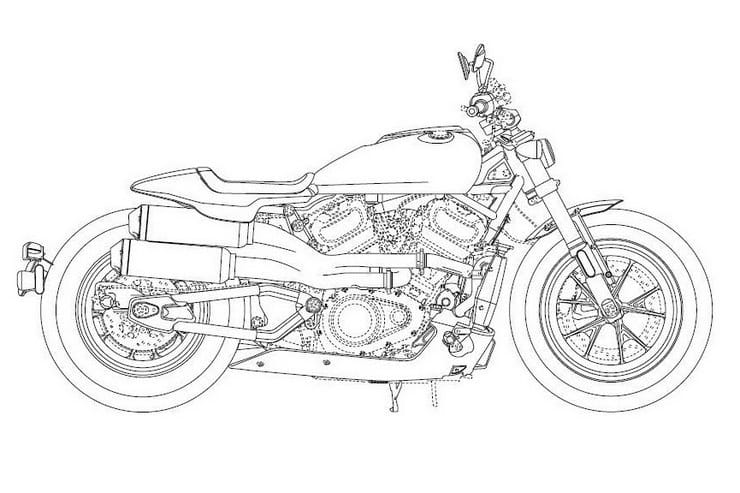Harley-Davidson has made intellectual property filings to protect the styling of three key models in its 2020-2021 range: the water-cooled Pan America, streetfighter and custom model that were previewed as concepts last year.
The designs detail some of the styling and technical changes we can expect to see when the production versions of the bikes are unveiled later this year. Filing them now will make it harder for other firms to copy them or use them on t-shirts, toys or even other motorcycles, which matters here because the styling was shown to the public a long way in advance of the actual bikes going on sale.
Last summer Harley-Davidson took the unprecedented step of announcing the outline of its new model plans for the next few years – explaining that it’s going to expand into several new sections of the market including adventure bikes, electric two-wheelers and streetfighter models.
While the LiveWire electric bike has now been revealed in production form, and goes on sale later this year, the expansion of the firm’s petrol-powered line-up is more essential to Harley’s immediate future. At last year’s announcement, the firm revealed that a new DOHC, water-cooled V-twin engine, in 975cc and 1250cc forms, would become the basis of a sportier Harley model range including a new adventure bike, the Pan America, plus an as-yet-nameless naked sports bike and a Ducati Diavel-style muscle cruiser.
It’s a middleweight model expansion that will see a huge growth in Harley’s range between now and 2022. In that time we’ll see the Pan America appear in both 975cc and 1250cc forms, the introduction of a nine-model streetfighter range extending from 500cc to 1250cc, and five custom bikes, also from 500cc to 1250cc. And that’s alongside up to six electric bikes, two small-displacement (sub-500cc) bikes and the continued evolution of Harley’s existing touring and cruiser range, which will gain between two and six models each year.
While Harley’s announcement was accompanied with images of concept versions of the Pan America, streetfighter and muscle-cruiser machines, the firm has now filed patents that give us a look at more production-ready versions of the designs.
Pan America
The first Pan America model – either 975cc or 1250cc – will be launched later this year as part of Harley’s 2020 range, with the other engine capacity joining the line-up in 2021.
The new design patent images, above, show that the production version will be very similar to the concept bike Harley revealed last year, but there are some noteworthy changes.
Let’s start with the elephant in the room – those barbeque grilles attached on either side of the rear wheel. Those are actually saree guards, a vital component on bikes sold in the Indian market, designed to stop the rider’s clothing getting dirty or tangled in the rear wheel. The fact that such guards are being incorporated at this relatively early stage of design rather is an indication of how seriously Harley is taking the Indian market for this bike. The guards won’t be fitted to versions sold in other markets, though.
The other significant change is the addition of cast alloy wheels instead of the wire wheels shown on last year’s concept version of the bike. Chances are that Harley will offer both wheel options, just as you can choose alloy or wire-wheeled versions of BMW’s GS models and Triumph’s Tigers.
There are detail changes to the bodywork, too, with deeper side panels below the seat and a new licence plate hanger at the back, plus tweaks to the belly pan and exhaust. However, the key styling elements – and notably the reverse-raked rectangular headlight – are unchanged.
You might also notice that the front mudguard looks odd. That appears to be a glitch in the wireframe 3d model used to create these images, where the mudguard has been moved into the wrong position.
Streetfighter
Harley’s streetfighter might not have a name yet but the firm clearly sees it as the most significant new machine of the new middleweight range. Eventually there will be nine derivatives, ranging from 500cc to 1250cc. That’s likely to include 500cc and 750cc machines based around the Revolution X V-twin used in the Street 500 and Street 750 models, plus 975cc and 1250cc models based on the new water-cooled engine design, which is the motor seen in these patents.
Again, the bike was shown as a concept last year, but there are changes in the patented version seen here.
As with the Pan America, the streetfighter has been designed with India in mind, hence the saree guard on the patent images. That won’t be fitted in other markets, though. Other differences compared to the concept include a new rear wheel design, which now matches the front wheel – the concept, unusually, has mismatched wheel designs. There’s also a production-style licence plate bracket, which was missing on the concept version, and slight changes to the exhaust and belly pan. The pillion footpegs are also changed; on the prototype they were on extended brackets attached to the rider’s peg hangers, but now they’re more conventional mountings coming from the subframe.
Although initially appearing as a naked bike, this platform is also expected to form the basis of a faired or half-faired sports bike at some stage between now and 2022.
When it comes to a name, Harley-Davidson trademarked the titles ‘Bronx’ and ‘48X’ at the same time as it established rights on the ‘Pan America’ title, so it’s likely the streetfighter will go under one of those monikers. The first production version of the bike is due in Harley’s 2020 model range, so expect an official unveiling later this year.
Cruiser
Harley’s moving back into its comfort zone with the muscle cruiser you see here. Although slightly further back in the firm’s model plans – the first production version isn’t due until 2021 – the bike was also shown as a concept last year.
The design patents reveal fewer changes than the Pan America and streetfighter models, but there are still some differences compared to the concept version.
Notably, the exhaust is different, and the belly pan is also changed slightly. We also see the mirrors moving from hanging under the bars to a conventional spot above them, while the licence plate hanger – which was notable on the concept because it housed all the rear lights and indicators in a seamless frame around the plate – has been swapped for something more conventional. That’s probably a reaction to the fact that plates vary in size and shape in different parts of the world. Perhaps the US version of the bike will keep the concept’s clever rear light design, but in markets like Europe where plate sizes are different, we’re likely to get a conventional layout as seen on these drawings.
With the first four models based on this design due to go into production in 2021 – probably in a variety of capacities from 500cc to the full 1250cc – and a fifth version coming in 2022, we’re unlikely to see the final production shape until late 2020.


























